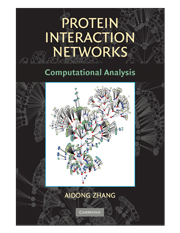Book contents
- Frontmatter
- Contents
- Preface
- 1 Introduction
- 2 Experimental Approaches to Generation of PPI Data
- 3 Computational Methods for the Prediction of PPIs
- 4 Basic Properties and Measurements of Protein Interaction Networks
- 5 Modularity Analysis of Protein Interaction Networks
- 6 Topological Analysis of Protein Interaction Networks
- 7 Distance-Based Modularity Analysis
- 8 Graph-Theoretic Approaches to Modularity Analysis
- 9 Flow-Based Analysis of Protein Interaction Networks
- 10 Statistics and Machine Learning Based Analysis of Protein Interaction Networks
- 11 Integration of GO into the Analysis of Protein Interaction Networks
- 12 Data Fusion in the Analysis of Protein Interaction Networks
- 13 Conclusion
- Bibliography
- Index
6 - Topological Analysis of Protein Interaction Networks
Published online by Cambridge University Press: 28 January 2010
- Frontmatter
- Contents
- Preface
- 1 Introduction
- 2 Experimental Approaches to Generation of PPI Data
- 3 Computational Methods for the Prediction of PPIs
- 4 Basic Properties and Measurements of Protein Interaction Networks
- 5 Modularity Analysis of Protein Interaction Networks
- 6 Topological Analysis of Protein Interaction Networks
- 7 Distance-Based Modularity Analysis
- 8 Graph-Theoretic Approaches to Modularity Analysis
- 9 Flow-Based Analysis of Protein Interaction Networks
- 10 Statistics and Machine Learning Based Analysis of Protein Interaction Networks
- 11 Integration of GO into the Analysis of Protein Interaction Networks
- 12 Data Fusion in the Analysis of Protein Interaction Networks
- 13 Conclusion
- Bibliography
- Index
Summary
INTRODUCTION
Essential questions regarding the structure, underlying principles, and semantics of protein-protein interaction (PPI) networks can be addressed by an examination of their topological features and components. Network performance, scalability, robustness, and dynamics are often dependent on these topological properties. Much research has been devoted to the development of methods to quantitatively characterize a network or its components. Empirical and theoretical studies of networks of all types - technological, social, and biological - have been among the most popular subjects of recent research in many fields. Graph theories have been successfully applied to these real-world systems, and many graph and component measurements have been introduced.
In Chapters 4 and 5, we provided an introduction to the typical topological properties of real complex networks, including degree distribution, attachment tendency, and reachability indices. We also introduced the scale-free model, which is among the most popular network models. This model exemplifies several important topological properties, which will be briefly summarized here:
■ The small-world property: Despite the large size of most real-world networks, arelatively short path can be found between any two constituent nodes. The smallworld property states that any node in a real-world network can be reached from any other node within a small number of steps. As Erdős and Rényi [100, 101] have demonstrated, the typical distance between any two nodes in a random network is the logarithm of the number of nodes, indicating that random graphs are also characterized by this property.
[…]
- Type
- Chapter
- Information
- Protein Interaction NetworksComputational Analysis, pp. 63 - 108Publisher: Cambridge University PressPrint publication year: 2009



